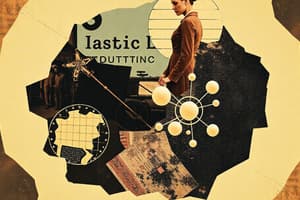Podcast
Questions and Answers
What did ancient Greek philosophers believe about matter?
What did ancient Greek philosophers believe about matter?
- Matter is composed of small, indivisible parts called atoms. (correct)
- Matter is composed of large particles.
- Matter has no particle structure.
- Matter is made only of gases.
Dalton's theory was the first to propose that atoms are divisible.
Dalton's theory was the first to propose that atoms are divisible.
False (B)
Who formulated the first atomic model based on experimental evidence?
Who formulated the first atomic model based on experimental evidence?
Rutherford
The nucleus of an atom contains _____ and _____ particles.
The nucleus of an atom contains _____ and _____ particles.
Match the following subatomic particles with their characteristics:
Match the following subatomic particles with their characteristics:
Flashcards
Atoms
Atoms
Smallest indivisible particles that make up matter. Ancient Greek philosophers believed in them but modern theories have revised the understanding.
Nucleus
Nucleus
The center of an atom containing protons and neutrons. It holds most of the atom's mass.
Protons
Protons
Positively charged particles found in the nucleus of an atom. Their number defines the element.
Neutrons
Neutrons
Signup and view all the flashcards
Electrons
Electrons
Signup and view all the flashcards
Study Notes
Atomic Structure
- Early Greek philosophers proposed atoms as fundamental, indivisible components of matter.
- John Dalton's 19th-century atomic theory posited atoms as indivisible particles.
- Ernest Rutherford's 1909 model, based on experiments, presented the first atomic model.
- The atom contains a tiny, dense nucleus composed of protons and neutrons.
- Electrons orbit the nucleus in specific energy levels.
- Protons, neutrons, and electrons are subatomic particles.
Studying That Suits You
Use AI to generate personalized quizzes and flashcards to suit your learning preferences.




